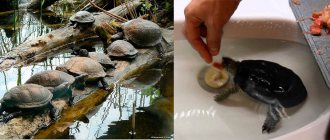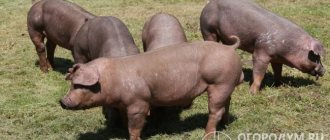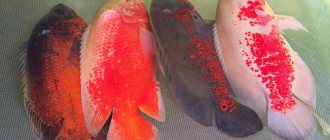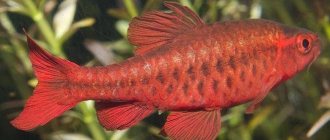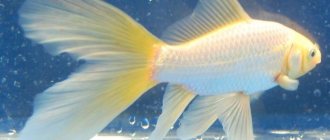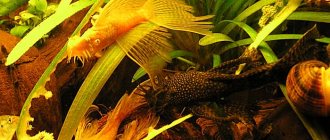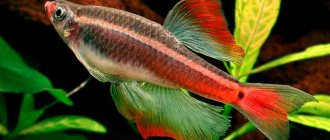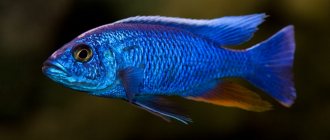- Wild animals
- >>
- Reptiles
The sand boa is one of the smallest species belonging to the boa family. This snake is sometimes kept as a pet: its movements in the sand are interesting to watch, it is relatively unpretentious and, despite its aggressive nature, is harmless to its owners. In the wild, boas live in Asian deserts.
History of the origin of the species - sand boa
The sand boa (Eryx miliaris) is a small snake from the Pseudopod family.
Snakes of this family do not have poisonous glands. The main method of killing prey is squeezing. The snake wraps itself around the victim and twists. This is reflected in the name of the species - boa constrictors. The boa constrictor is the smallest representative of its family. The evolution of these reptiles has followed the path of searching for the least energy-consuming existence - most of the time they lie peacefully in a shelter or hang on branches. They attack the prey when it gets too close to the reptile and spend a long time digesting the caught animal.
Appearance of a sand boa
The name "Eryx miliaris" in Latin means "millet-like erysipelas" because the first thing that catches your eye when you see this snake is its very small eyes. This gives the snake its special appearance.
Interesting Facts
- Boa constrictors strangle their victims using the following technique: by wrapping themselves around the chest of the prey, the boa constrictor “tightens” its rings on its chest as it exhales. As a result of 2-3 exhalations, the victim has almost no air left in his lungs, and he can no longer breathe.
- Boas, like other amphibians, are cold-blooded animals, i.e. their body temperature depends on the ambient temperature. The activity of boa constrictors also depends on this. The higher the temperature, the more active they behave. The best way to calm a boa constrictor is to lower the temperature in the terrarium.
- What distinguishes boas from other snakes is their ability to hunt in zero visibility. They have temperature-sensitive receptors located between the eyes and nostrils. These organs detect the heat emanating from the body of the intended victim at a considerable distance in complete darkness, allowing the boa constrictor to hunt at night as effectively as during the day.
- Most snakes use their tongue to collect particles present in the air, while the nostrils they have are used only for breathing. When the snake retracts its tongue, the particles are absorbed by special cavities on the roof of the snake's mouth, thus allowing it to perceive odors.
Video
https://youtube.com/watch?v=9EuHwH_Yq-c
Sources
- https://nashzeleniymir.ru/boa constrictor https://ru.wikipedia.org/wiki/Ordinary_boa constrictor https://www.vetprofy.ru/stati/ekzoticheskie-zhivotnye/udavy-opisanie-vidov-i-interesnye-fakty https:// www.nochnichok.ru/home/2014/07/29/udav-v-domashnih-uslovijah-gde-soderzhat-i-chem-kormit.htmlhttps://www.moscowzoo.ru/animals/reptilii/obyknovennyy-udav/ https://zoo-dom.com.ua/acatalog/379/120/593.htm
Anatomical features of the sand boa
Sand boas have a short, wide body. The length is no more than 80 cm. The weight of the individual is about 350 g. In addition to the main parts of the skeleton - the skull, spine and ribs, the boa has rudiments of the hind limbs. This feature is inherent in all representatives of the Pseudopod family. Externally, the rudiments look like small claws on the lower back of the body.
The snake is colored light brown with dark spots.
Interesting! Melanism is common among boas. Such individuals are painted in black and gray tones.
Coloration of the sand boa with melanism
The skull of this reptile is flattened. the frontal bone is slightly pressed inward. There is a small shield. The maxillary bone is enlarged and pushed forward. Thus, the mouth is located on the underside of the head. The eyes are small and round. There are no protective formations above the eyes. The peculiarity of the species is the yellow color of the main part of the eye, so that it merges with the color of the scales. The pupil is vertical.
Location of the eyes of the sand boa
On the jaws there are many small teeth directed inside the mouth. The front teeth are longer than the back teeth.
Sand boas have developed sexual dimorphism.
Females and males have different body lengths, the ratio of tail to body length, and the number of scutes. Table 1 - Differences in the structure of females and males of the sand boa
| Parameter | Meaning | |
| Males | Females | |
| Probe penetration depth (by number of shields) | 8 – 12 | 2 – 4 |
| Average number of subcaudal scutes | 26 | 21 |
| Tail length percentage of total length | 11% | 7,9% |
| Total length of adults | 30 – 38 cm | 50 – 71 cm |
Appearance of boas
Considering the lifestyle described above, the body of the boa has a dense, muscular structure of almost cylindrical shape.
The tail of boas is blunt and short, there is no neck narrowing, the head is flattened and short. Particular attention should be paid to the structure of the head of boas: the upper jaw of these reptiles is pushed forward and has a wedge-shaped shape. As a result of this structure, the mouth opening is located not in front, but below.
Boas are completely harmless creatures.
The dimensions of the intermaxillary shield are very large, as a result of which it extends to the top of the head. As a result of such features, it is the upper jaw of boas that is the main digging tool, while the intermaxillary shield takes on the main function during movement in the soil.
The eyes of boas are small in size and are always turned upward to one degree or another. This creates a noticeable advantage when looking out of the ground onto the surface, since with such an eye structure there is no need to stick the entire head out to the surface. On both jaws of boas, the front teeth are slightly longer than the back teeth.
Features of character and lifestyle
Sand boas prefer sandy terrain with sparse vegetation. During the day, when temperatures are too high, it buries itself in the sand, wriggling its body. Active in the evening and at night.
Interesting! Boa constrictors are capable of not only burying themselves in sand, but also moving under the substrate. Most likely, this is why the eyes are located on the upper part of the body. The burrowing function is performed by the intermaxillary shield.
A sand boa peeks out from the sand.
The movement of a sand boa under the sand is clearly visible by the rising tubercle.
Sand boas are very slow at any time except when attacking. If the victim approaches the snake within throwing distance, the reptile instantly grabs the prey, holds it with its teeth and wraps it around its body.
Boa constrictors are not conflict snakes. When they see a person they try to hide. But often a snake and a person meet by chance. If a person approaches a snake, it may try to free itself or bite.
Sand boa bite mark
Important! Boas have very strong trunk muscles, so even if you grab it by the tail, it can twist itself out to attack. The snake's bite is very strong, as the teeth are adapted to hold the squirming victim.
Tip #1. Despite the fact that boas are non-venomous, you should not grab them with your hands, as they can seriously injure your hands and tear your clothes.
Boa behavior
Boas strangle their victims by wrapping their muscular body around them in two or three rings. As a rule, the boa first creeps up on potential prey and, rushing at it with lightning speed, grabs it with its jaws, and then, like other boa constrictors, wraps rings around it and suffocates it. The active season of boas begins in March-April and ends in September-October. At the same time, at the beginning of the active season, boas are characterized by a single peak of daily activity. However, by summer, the single-peaked peak gives way to a double-peaked peak of daytime activity and boa constrictors show maximum activity first in the early morning and then in the evening and at night.
Diurnal activity is twilight-night; boa constrictors can be found in the first half of the night.
At the same time, boa constrictors obtain food for themselves not only by lying in ambush, but also by actively searching for prey in the burrows of various rodents and on the soil surface. Some individuals simply stick to old, crumbling buildings where mice or large gerbil colonies may live.
Where does he live?
The species is distributed in desert and semi-desert regions of the southeastern European part of Russia, Kazakhstan, Central Asia, northern Iran and Afghanistan. inhabits sandy substrates with sparse vegetation. Can live on fine rocky soils.
Boa constrictor on rocky slopes. Some scientists distinguish this population into a separate subspecies
Where in Russia and neighboring countries does the sand boa live?
In Russia, the boa constrictor has been recorded in the Ciscaucasia. It is also found in Azerbaijan, southern Armenia, eastern Georgia, and Dagestan. Rare finds are listed in the south of the Stavropol Territory, North Ossetia and Kalmykia.
In these areas, the boa chooses rocky, clayey or sandy substrates of the steppe, semi-desert or desert.
FLOATING IN THE SAND
The genus of boas includes 9 or 10 species of medium-sized ovoviviparous snakes that live in desert regions. All of them are, to one degree or another, adapted to a burrowing lifestyle: they have small eyes and a small head covered with scutes. The easiest way to distinguish boas from other snakes is by their short, blunt tail. Another characteristic feature is the narrow ventral scutes, which cover only about a third of the ventral surface.
The sand boa is one of two species of this genus found in Kazakhstan. In addition, it is widespread in the deserts of Northern Iran, Afghanistan, Central Asia, Eastern Ciscaucasia and the southern part of the Lower Volga region. It prefers semi-fixed hummocky and dune sands; less often it can be found on takyrs and on denser loess and clay soils. Often these snakes inhabit colonies of rodents, especially great and midday gerbils.
The dexterous boa is able to quickly burrow into loose sand head first and secretly “swim” in it, leaving a characteristic mark in the form of a serpentine sand roller at the dive site. The eyes, located high on the head, allow the burrowing reptile to inspect the surface while remaining invisible to potential victims and enemies. The slit-like shape of the nostrils prevents sand from entering them.
Is the sand boa dangerous to humans?
The boa constrictor, like all pseudopods, does not contain poisonous glands. However, it is quite capable of biting. Often boa constrictors bite those who are nearby, as they attack from an ambush without seeing the victim. Sometimes people grab a snake by the tail, thinking that this will avoid being bitten. The boa constrictors curl up and bite the offender. This is due to the fact that they have a highly developed muscular system. The bite is very painful, because the mouth is powerful and the teeth are strong.
The danger of such a bite can be infection in the wound. In such a lacerated wound, without the necessary treatment, blood poisoning and serious inflammation can develop.
Tip #2. After being bitten by a sand boa, you should wash the wound with disinfectants and apply a bandage. If inflammation develops, you should consult a doctor.
From worm and lamprey
How the sandworms of Herbert's epic work and how they live - we will answer this question based on the text of Dune, but even more so on the book Encyclopedia of Dune. The first edition of this encyclopedia was published in 1984, edited by professor-philologist Willis McNally, who attracted many specialists in various fields of knowledge to work on it. From it we know that great worms have a long, segmented body and a mouth funnel lined with crystalline teeth.
The sizes of the worms are really large - the largest of them reach several hundred meters in length, the largest male of those noted reached 400 meters, while the diameter of his mouth was 80 meters, and the smallest female was 100 meters in size with a mouth diameter of 20 meters. The first segment of the body forms the head, one of the subsequent ones is engaged in reproduction, and the others are not differentiated.
Giant earthworm ( Glossoscolecidae
), photograph taken in French Guiana
Bernard Dupont/Flickr
Share
In the last part of the description, the zoologist recognizes an annelid (phylum
Annelida
, which includes polychaetes and oligochaetes, leeches and mysostomids). Like terrestrial annelids, Arrakis worms are capable of regeneration, and even one segment, separated from all the others, can remain viable.
“You have to shock them with high voltage, each segment of their body separately,” Kines explained. - This is the only way. They can be put to sleep with a stunner, slightly stunned by an explosion, even torn - but each body segment will live separately. Moreover, I don’t know what kind of explosive - excluding nuclear weapons - can destroy the entire worm. They are extraordinarily resilient."
— “Dune”, book I, chapter 13, translation by Pavel Vyaznikov.
Among the annelid earthworms there are large species, for example, the giant Australian worm Megascolides australis
can reach three meters in length, and the giant African worm
Microchaetus rappi
is 6.7 meters, but all of them are two orders of magnitude smaller than the creations of Herbert’s imagination.
Mouthparts of the sea lamprey Petromyzon marinus
T. Lawrence, Great Lakes Fishery Commission / Flickr
Share
However, the mouthparts of worms (according to most of the Dune illustrators, three-lobed) make us remember completely different creatures. Their main weapon resembles, on the one hand, the mouthparts of a lamprey, and on the other, the mouthparts of leeches. Lampreys are primitive jawless vertebrates, leeches are a subclass of annelids, many of them lead a parasitic lifestyle, attach themselves to the victim and drink its blood. Lampreys have a pre-oral funnel, densely lined with horny teeth. In leeches, the mouth opening is located at the bottom of the anterior sucker; in some, proboscis, the pharynx moves forward, and in jawed leeches there are three cutting chitinous jaws.
Dune, Omni Magazine July 1980
John Schoenherr
What does the sand boa eat?
Boa constrictors catch everything that happens to be nearby. The basis of their diet consists of:
- Lizards;
- Snakes;
- Turtles;
- Small rodents;
- The bats;
- Chicks.
A constrictor swallows a mouse.
Sometimes, the caught prey turns out to be too large to swallow, then the snake abandons its victim.
Diet of boas
Rodents, such as house mice, mole voles, gray hamsters, gophers, jerboas and gerbils, occupy the most important place in the diet of boas. Constrictors also eat birds (tree sparrows and white wagtails) and lizards (long-legged skinks, skink geckos, various foot-and-mouth lizards, takyr and long-eared roundheads, and steppe agamas). Young turtles and small snakes are also eaten. Young boas feed, accordingly, on smaller prey, such as insects and young-of-the-year lizards.
Boas strangle their prey with two or three rings of their muscular body.
How does the sand boa reproduce?
Boas are ovoviviparous. This means that they lay eggs, which immediately hatch into small snakes.
Female sand boa with born offspring
Table 2 - Main stages of reproduction of adults and development of offspring
| Stage | Condition | Deadlines | Period |
| mating season | After coming out of hibernation | 3 months | April May |
| Egg development | Successful fertilization | 6 – 8 weeks | June July |
| Incubation | Temperature from +23.5 to +31.9 °C, constant humidity | 33-41 days | July – first half of August |
| First food | – | – | Yolk of your own egg |
| First hunt | Successful birth | 4 – 9 days | August |
| Wintering care | Anyway | – | Late September – early October |
| Reaching puberty | Successful Survival | 4 years | |
Young snakes appear relatively large: up to 12 cm in length. They immediately bury themselves in the sand and begin to hunt. Juveniles are available only to the young of other animals - chicks, young of the year of lizards and turtles. After the first feeding, the snakes go to winter. The female can produce up to 15 baby snakes. The older the snake, the more offspring it can have.
Reproduction of boas
Boas apparently reach sexual maturity in the fourth year of life. All boas are ovoviviparous. With this method of reproduction of offspring, the characteristics of oviparity and viviparity are combined. An ovoviviparous female does not lay eggs, but carries them inside her body. The cubs emerge from the egg shell while still in the mother's body and only after that are born.
At the same time, the main difference between ovoviviparity and placental viviparity is that during ovoviviparity, the embryo feeds on most of the substances contained in the egg yolk and is thereby separated from the metabolism of the maternal body, although in some cases a certain degree of connection with the maternal body is maintained. In contrast, the embryos of viviparous snakes (and not only) are fed directly from the mother’s body.
Scientists suggest that ovoviviparity evolved in a number of lizard species as an adaptation to reproduction in temperate climates. It should be noted that ovoviviparity is not an exotic form of reproduction. In fact, only higher mammals are a large taxonomic group with a developed practice of direct viviparity. As for the other species that give birth to their young alive, they are all ovoviviparous and boas in this regard are more typical than exotic animals.
All boas are ovoviviparous; the female gives birth to up to 20 young.
As for the number of offspring, a female can give birth to up to twenty cubs at a time. The body length of newborn boas ranges from twelve and a half to fifteen centimeters.
Lifespan
Sand boas lead a secretive lifestyle, so it is difficult to determine the exact age. With proper care at home, these reptiles can live 25 years. In wild forms, this period will be lower, since life expectancy is limited by a number of factors:
- Availability of food resources;
- Presence of natural enemies;
- Availability of suitable conditions for molting;
- Stress.
Boa constrictor before molting.
The eyes become cloudy, the color fades and darkens. The boa constrictor constantly sheds the same way as all reptiles. This is the only time it needs water to soften the old skin. If there is no rain for a long time and water bodies dry up, the molting process is disrupted. In this case, the snake does not feed well and becomes sluggish and disoriented. Such a snake can become an easy prey for predators.
Important! You cannot handle a snake that has not gone through the molting period. Due to disorientation, the level of aggression increases.
Natural enemies of snakes
There are practically no herbivorous forms of animals in the desert.
Often in such conditions it is not immediately clear who is the predator and who is the prey. Natural enemies of the sand boa include: Table 3 - Natural enemies of the sand boa and the nature of the relationship with them
| Predator | Frequency | Cause | Is the boa constrictor included in its food supply? | Methods of protection |
| Predator birds | Rarely | No way to catch the snake | Yes, chicks | Burying in the sand, squirming |
| Snakes | Often | High numbers | Yes | Burying in sand, biting and suffocating |
| Lizards | often | High numbers | Yes, fingerlings and adults | Burying in sand, biting and suffocating |
| Jerzy (in the steppe) | Rarely | Adult snakes are too large for a hedgehog | Yes, young ones | Burying himself in the sand |
| Dogs | Rarely | Due to the expansion of human-developed territories | No | Buries itself in the sand, squirms and bites back |
Types of snakes, photos and names
The planet is home to a huge variety of different species of snakes. Of these, zoologists identify ten main ones.
Common snake
Common snake
This species is considered the most widespread, since it lives in the CIS countries, Europe, Asia, and Africa. It is easy to recognize the common grass snake by its two light spots located above the eyes. The snake prefers to settle in a humid climate, near bodies of water.
Water snake
Water snake
Lives on the banks of rivers and seas, spending most of the time in water. Individuals hunt there and are able to swim long distances. The snake has an olive color with different shades. Multi-colored spots may also appear on the body. Unlike the common snake, the water snake does not have white markings on its head, but has a dark V-shaped pattern on the back of its head. An adult grows up to 1 m in length.
Big-headed snake
Big-headed snake
Most of the species live in Russia and Georgia. The snake prefers forests and mountains as its habitat. Individuals are black in color and have a white belly; there are no markings on the head. A distinctive feature of this species of snake is its large flattened head.
Viper snake
Viper snake
It lives in the southwest of the Mediterranean, and got its name for its resemblance to a viper. The snake has a dark gray back with large spots. Representatives of this species grow up to 60 cm in length, with females being much more massive than males.
Tiger snake
Tiger snake
This species is found in Russia and Asia. Prefers to live near grass that loves moisture. The tiger snake is nicknamed for the yellow-orange spots located on the sides of its black scales. Because of this, its color resembles the animal of the same name.
Shiny tree snake
Shiny tree snake
It lives in southeast Asia, and lives near human settlements. Prefers to climb tall trees or hide in bushes. Most individuals are green-brown in color with an olive belly.
Interesting fact: the tail of the shiny tree snake is about a third of its entire length.
Schneider's fish snake
Schneider's fish snake
Lives in ravines and rivers, found in Pakistan, India, Malaysia and Sri Lanka. The maximum length of an individual is 1.3 m, the color is gray with black or white spots located in a checkerboard pattern. Although the snake is not poisonous, it is quite aggressive and can fight back against its offender.
Eastern ground snake
Eastern ground snake
It lives in the USA, the size of the individual does not exceed 30 cm. It has a brown color and a light belly, sometimes there are black spots on the body. It prefers loose soil as a habitat, where it searches for insects and hides from enemies.
Bush green snake
Bush green snake
The snake has a bright green color with black and brown spots. It lives in areas of Africa filled with vegetation. Prefers to hide in trees, blending in with the foliage. Also found in rocks and rivers. It prefers frogs, lizards and chameleons as food.
Red Book
The sand boa species is experiencing a large number of factors of population decline. One of the main ones is human economic activity, which is reducing the habitat of the species. In some regions the species is protected. This reptile is listed in the Red Book of the Ciscaucasia in the status of “vulnerable species”, as well as in the Red Books of the Republic of Dagestan, Stavropol Territory and Astrakhan Region in the status of “rare species”. The exact number of individuals in different populations has not been established, since snakes spend most of their time in the sand.
Sand boa in the Black Lands steppe reserve
You can't kill snakes. This will upset the balance of numbers and provoke the proliferation of rodents. Many rats and mice carry diseases that are dangerous to humans, and also spoil millet supplies. An increase in the number of insects will lead to damage to fruit trees, the development of sawflies and mosquitoes.
Methodist of the Central Park of Culture and Culture named after. P.P. Belousova, Ph.D. herpetologist Inna Vladimirovna Shiryaeva.
How many nerves
According to the Dune Encyclopedia, each segment of the worm has its own primitive nervous system, but how long can it take for a nerve impulse to travel from the first, head segment of a great worm to its terminal segments? The largest nerve cells in Earth's organisms are the giant squid axons, reaching 1.5 millimeters in diameter in the giant squid Architeuthis dux
. On average, for an axon 0.5 millimeters thick, the speed of impulse transmission reaches 25 meters per second, which means that the signal travels from the head to the tail of the great worm for several seconds.
Giant squid axon
NIH History Office/Wikimedia Commons
Share
Great worms are known to sense vibrations in the soil, a skill common among terrestrial organisms. Elephants, gerbils and kangaroo rats communicate over long distances, listening to the stomping of feet, spiders “hear” when someone is caught in a web by the vibrations of its threads, and earthworms are able to sense vibrations in the soil, which fishermen use to lure them to the surface.
However, with regard to earthworms, it is not known for sure whether they are afraid of moles that prey on them, or mistake the vibrations for the sound of rain. As follows from Herbert's novel, the Fremen attracted great worms with a special apparatus, a decoy-beater, emitting low-frequency vibrations. On Earth, earthworms are lured out of the ground not only by fishermen; some birds and turtles get their food by tapping the soil and collecting crawling worms.
Desert biotope, planet Earth, Tajikistan, sands of Kurjalakum.
Photo by the author of the text.
Keeping the sand boa in captivity
The sand boa has a calm disposition and is not picky about conditions. For this reason, it is often kept in terrariums. The snake must be kept in a wide terrarium. Approximate dimensions: 60*40*30. Be sure to place a loose substrate: sand, fine crushed stone or coconut shavings. An important condition for keeping a snake is temperature. During the day 230 - 250C, at night no more than 200 - 210C. It is better to maintain the temperature using an ultraviolet lamp.
Boa constrictor in a terrarium on a sawdust substrate
It is best to create different temperature conditions in opposite corners of the terrarium.
If the female is “pregnant”, the temperature should be much higher: 30 – 350C.
Interesting! Some snake owners note that if you place a snag in a terrarium, the boa constrictor will happily climb onto it and hang there for a long time.
It is necessary to feed the snake with live food - small lizards, mice, chicks. The boa does not “see” non-living food, but some people heat non-living food to feed it to their pet.
Important! You should not feed a boa from your hands, because the smell of a person begins to be associated with food, and subsequently the pet may bite.
Reptiles must be maintained at high humidity (at least 50%) during the molting period.
Boas get used to their owner well. If you often pick up a reptile, the pet gets used to the warmth and smell. He behaves very calmly in his arms.
Boa constrictor in hands
Tip #3. It is worth accustoming your pet to handling when it is full, does not shed, and is calm. At other times, difficult situations may arise.
Description
This reptile is the smallest member of the boa family. Its small size and harmlessness have led to the fact that today the boa constrictor is increasingly kept as an exotic pet. Like most representatives of the animal world among amphibians and arthropods, female snakes are larger than males. Females can grow up to 80 cm in length, while males reach only up to 60 cm. A distinctive feature of this subspecies is the unusual structure of the eyes: they are small, black and located at the top of the head (the eyes are almost always directed upward). It is believed that this feature is a means of self-preservation - in this way this snake from the boa constrictor family protects itself from a sudden attack from a predator from the air.
Important! Boa constrictors lead a solitary lifestyle, so it is not worth housing them in pairs - this is only permissible during mating periods. The boa constrictor has a sandy, pale yellow color with gray spots
There are rather sharp fangs in the mouth, but the bites of such a snake are safe - they contain absolutely no poison. In its natural environment, the boa constrictor feeds on small rodents, birds (especially chicks), bird eggs, and small insects. In particularly hungry times, it is even capable of swallowing a small turtle or small snakes. The reptile's lifestyle is quite secretive: they hunt only at dusk or in the morning.
Despite this precaution, they often themselves become victims of larger predators.
The boa constrictor has a sandy, pale yellow color with gray spots. There are rather sharp fangs in the mouth, but the bites of such a snake are safe - they contain absolutely no poison. In its natural environment, the boa constrictor feeds on small rodents, birds (especially chicks), bird eggs, and small insects. In particularly hungry times, it is even capable of swallowing a small turtle or small snakes. The reptile's lifestyle is quite secretive: they hunt only at dusk or in the morning.
Despite this precaution, they often themselves become victims of larger predators.
Did you know? There is a misconception that the meat of these snakes is
«effective cure for 1001 diseases
"
.
Official medicine does not confirm this fact - nevertheless, thousands of individuals die every year due to the ignorance of people chasing the supposedly universal medicine from reptile meat. In captivity, these snakes live in specialized terrariums where a constant temperature is maintained: these heat-loving creatures love a temperature of at least +22°C. This is also due to their natural habitat - the deserts of Kazakhstan, Uzbekistan, as well as some regions of Russia, China and Mongolia. Boas are also picky about air humidity: in terrariums, the amount of moisture in the air should not be less than 50%. But in the field of nutrition, reptiles are less picky about food than in their natural environment. The lifespan of boas in captivity can reach 15 years.

